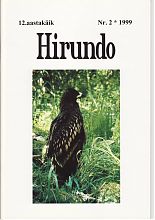Hirundo 2/1999
Lilleleht, V.
Rarities in Estonia 1990-1997: report of the Estonian Rarities Committee
Summary: This second report of the Estonian Rarities Committee (founded in 1977) covers the years 1990-1997, but many earlier records have been also included. Altogether 759 records were definitely assessed (Table 1), and 624 (82%) of these were accepted. From the period 1990-1997, 597 records were considered (44-105 records annually), of these 544 (91%) were accepted. In different years the frequency of accepted records was 76-99%.
The records are listed in systematic order and presented chronologically. Records of birds of unclear origin, escapees from captivity, corrections and changes, records not accepted, and records formerly accepted but now rejected are listed separately from the main list of accepted records.
The four numbers in brackets after species’ name (a/b – c/d) indicate (a) the total number of records before 1990, (b) the number of individuals (if possible to judge) before 1990; © the number of records in 1990-97, (d) the number of individuals in 1990-97. X instead of a number means unknown number of records or individuals.
The details included for each record are: date(s), locality, parish (khk.), district, number of individuals (is., isend), pairs (paar), nests (pesa) etc. if more than one, sex and age (if known; a = calender year) and names of observers. The meaning of some Estonian terms and expressions: algus = beginning, lõpp = end, ja = and, läh. = near, vahel = between, jv. =lake, s. = island, laht = bay, kuni = up to, pesakond = brood, (tõenääoliselt) sama isend = (probably) the same individual, pesitsemine =breeding, pesitsusaegsed teated = records from breeding period.
In 1990-1997, 13 new species in an apparently wild state (AERC category A) were added to Estonian list: in 1990 Neophron percnopterus, Rissa tridactyla (altogether 10 records in the whole period), Motacilla citreola (10) and Acrocephalus agricola (4), in 1992 Gavia adamsii (12), Anthus hodgsoni and Acrocephalus paludicola, in 1993 Aquila nipalensis and Luscinia megarhynchos, in 1996 Pluvialis fulva (3) and Pagophila eburnea and in 1997 Himantopus himantopus and Sterna nilotica. In 1990, the race variegata and in 1993 the race maura of the Stonechat (Saxicola torquata), and in 1991 the American race columbianus of the Tundra Swan (Cygnus columbianus) were for the first time. Also one species of unclear origin (category D) – Bucanetes githagineus – was recorded for the first time in 1997 in Estonia.
The records of Platalea leucorodia, Rhodostethia rosea and Dendrocopos medius were second records for the country. The records of the race Branta bernicla hrota were the third to fifth, of Tyto alba third to fourth, of Tarsiger cyanurus third, of Saxicola torquata third to fifth, of Hippolais caligata third, of Phylloscopus fuscatus third to fifth, whereas those of Burhinus oedicnemus and Phylloscopus borealis fourth to fifth in Estonia.
In the same period the breeding of Aquila clanga, Motacilla citreola and Panurus biarmicus in Estonia was confirmed, as well as an accidental breeding of Calidris temminckii in 1993. On the other hand the single formerly accepted nesting record of Aythya nyroca in the country (in 1974) was reviewed and rejected.
Altogether, 335 species of apparently wild state or released species which have established self-supporting breeding populations in Estonia or in neighbouring countries (i. e. categories A-C) and five species of unclear origin (category D) have been recorded in Estonia by 1.1.1998. The whole list of Estonian bird species and list of those considered by the Estonian RC was published earlier.53 The list of species and subspecies of which only earlier records will be considered by the RC is given as Appendix 1.
EOS chronicle and news

